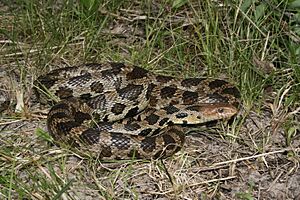Fox snake facts for kids
Fox snakes are cool, non-venomous snakes found in North America. They get their name because some people think they smell a bit like a fox! These snakes are part of a group called rat snakes, which are known for eating rodents. There are two main types of fox snakes that scientists generally agree on: the Eastern Fox Snake and the Western Fox Snake. They are important parts of their ecosystems, helping to control populations of small animals.
Contents
What Are Fox Snakes?
Fox snakes belong to the genus Pantherophis. This means they are related to other well-known snakes like corn snakes and other rat snakes. They are constrictors, which means they squeeze their prey to catch it. Fox snakes are not venomous, so they are not dangerous to humans. They are often mistaken for other snakes, but their unique markings and habits help identify them.
Where Do Fox Snakes Live?
Fox snakes live in different parts of central and eastern North America.
- The Western Fox Snake (Pantherophis vulpinus or Pantherophis ramspotti) is found in the central United States. This includes states like Illinois, Iowa, Wisconsin, and parts of Minnesota and Missouri. They prefer open woodlands, prairies, and farmlands.
- The Eastern Fox Snake (Pantherophis gloydi) lives further east. You can find them in parts of Michigan, Ohio, and Ontario, Canada. These snakes often live near wetlands, marshes, and sandy areas close to water.
Both types of fox snakes like places where they can find good hiding spots and plenty of food.
What Do Fox Snakes Look Like?
Fox snakes are medium to large snakes. They can grow to be about 3 to 5 feet long. Some have even been recorded at over 6 feet!
- Their bodies are usually yellowish, tan, or light brown.
- They have dark brown or black blotches (spots) along their backs. These blotches are often outlined in black.
- Their heads might be plain brown or reddish, especially in Eastern Fox Snakes.
- Their bellies are usually yellowish with dark checkerboard patterns.
- Young fox snakes look similar to adults but might have brighter colors.
When they feel threatened, fox snakes might vibrate their tails. This can sound like a rattlesnake, which helps scare away predators.
What Do Fox Snakes Eat?
Fox snakes are carnivores, meaning they eat meat. Their diet mainly consists of small animals.
- They love to eat rodents like mice, voles, and young rats. This makes them very helpful to farmers!
- They also eat small birds and their eggs.
- Sometimes, they might eat frogs or other small reptiles.
Fox snakes are excellent hunters. They use their sense of smell to find prey. Once they catch an animal, they wrap their bodies around it and squeeze until it stops moving. Then, they swallow their meal whole.
How Do Fox Snakes Behave?
Fox snakes are generally shy creatures. They prefer to avoid humans.
- They are active during the day, especially in spring and fall.
- In the summer, they might become more active at dawn or dusk to avoid the heat.
- When winter comes, they find safe places to hibernate. This could be in rock crevices, mammal burrows, or under logs.
- If a fox snake feels scared, it might coil up and strike. However, they are not aggressive. They usually try to escape first.
- As mentioned, they can vibrate their tails to mimic a rattlesnake. This is a clever way to scare off animals that might want to eat them.
Fox Snake Life Cycle
The life cycle of a fox snake begins with eggs.
- Mating usually happens in the spring, after they come out of hibernation.
- Female fox snakes lay a clutch of eggs in early summer. A clutch can have anywhere from 7 to 29 eggs.
- They often lay their eggs in hidden, warm places. This could be under logs, in rotting stumps, or in piles of leaves.
- The eggs hatch about 60 to 70 days later, usually in late summer or early fall.
- Baby fox snakes are born looking like smaller versions of the adults. They are independent from birth and must find their own food and shelter.
- Fox snakes can live for 15 years or more in the wild.
Are Fox Snakes Dangerous?
No, fox snakes are not dangerous to humans. They are non-venomous. If you see one, it's best to leave it alone and observe from a distance. They are more afraid of you than you are of them!
- They play a vital role in their environment by controlling rodent populations. This helps keep ecosystems healthy.
- Sometimes, fox snakes are mistaken for venomous snakes, like rattlesnakes. This can lead to them being harmed. Learning to identify them helps protect these beneficial creatures.
- Habitat loss is a threat to fox snakes. Protecting their natural homes is important for their survival.
Types of Fox Snakes
While there has been some scientific discussion, most experts agree on two main species of fox snakes:
- Eastern Fox Snake (Pantherophis gloydi): This species was first described in 1940. It is found in the eastern parts of their range.
- Western Fox Snake (Pantherophis vulpinus): This species was first described in 1853. It is found in the central parts of their range.
- A third name, Pantherophis ramspotti, was proposed in 2011 for the western population. However, it is often considered to be the same as Pantherophis vulpinus by many scientists.
Understanding these different types helps scientists and conservationists protect them.


